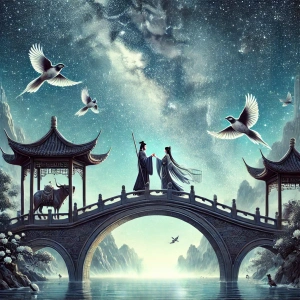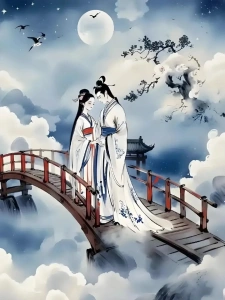
Chinese Valentine’s Day, also known as the Qixi Festival, is a beloved traditional festival in China that celebrates the annual meeting of the Cowherd and the Weaver Girl. Based on an ancient Chinese myth, this festival tells the poignant story of two star-crossed lovers who are allowed to reunite just once a year—on the seventh day of the seventh lunar month. In 2025, Chinese Valentine’s Day falls on August 29.
The story of the Cowherd and the Weaver Girl is one of the most celebrated tales of love in Chinese folklore. Legend has it that the Weaver Girl, a celestial being and the granddaughter of the Heavenly Emperor, descended to Earth and fell in love with the Cowherd, a humble mortal. Their secret marriage led to the birth of two children. Upon discovering their union, the Heavenly Emperor furiously summoned the Weaver Girl back to the heavens. Aided by his loyal ox, the Cowherd ascended to the skies in pursuit of his wife, only to be thwarted by the Heavenly Emperor who created a vast river of stars—the Milky Way—to keep them apart. Touched by their unwavering love, the magpies form a bridge across the Milky Way every year, allowing the couple this one day of reunion, thus establishing the tradition of Chinese Valentine’s Day.

Chinese Valentine’s Day and Western Valentine’s Day both celebrate love, yet they stem from very different cultural and historical roots. While Western Valentine’s Day has evolved into a highly commercialized holiday involving the exchange of flowers, chocolates, and cards, Chinese Valentine’s Day remains deeply rooted in rich traditions such as weaving, needlework, and stargazing—each steeped in symbolic meaning that honors the festival’s ancient origins.
Chinese Valentine’s Day is marked by a blend of age-old customs and modern practices that reflect the festival’s evolving nature.
Traditionally, Chinese Valentine’s Day has been an occasion for women to demonstrate their artistic skills, particularly in crafts like weaving and embroidery. These activities are not only a nod to the celestial Weaver Girl but also symbolize the pursuit of beauty and love.

As times have changed, the observance of Chinese Valentine’s Day has embraced contemporary elements. Nowadays, couples celebrate by exchanging flowers and gifts, dining out, or taking short trips together. These modern traditions keep the spirit of Chinese Valentine’s Day alive and vibrant among the youth.
More than just a festival of romance, Chinese Valentine’s Day embodies deep cultural values about loyalty, love, and family responsibilities within Chinese society. The enduring tale of the Cowherd and the Weaver Girl not only conveys a message of relentless love and commitment but also serves as a cultural legacy, allowing younger generations to connect with and appreciate their rich heritage.
As a widely celebrated occasion, Chinese Valentine’s Day significantly impacts the economy, with businesses capitalizing on the event through special promotions and discounts. Additionally, the festival enjoys considerable popularity on social media, where people eagerly share their personal celebrations, contributing to a broader dialogue and greater communal engagement.
Learn dates, customs, and celebrations of major Chinese holidays to effectively plan your vacations and trips.

 English (Singapore)
English (Singapore)